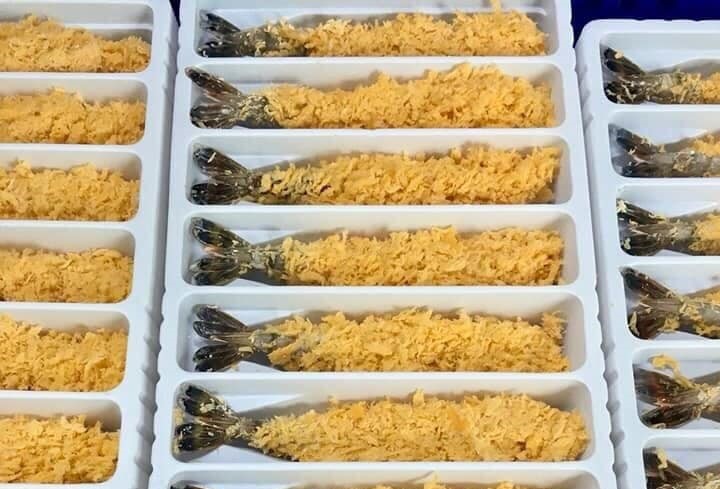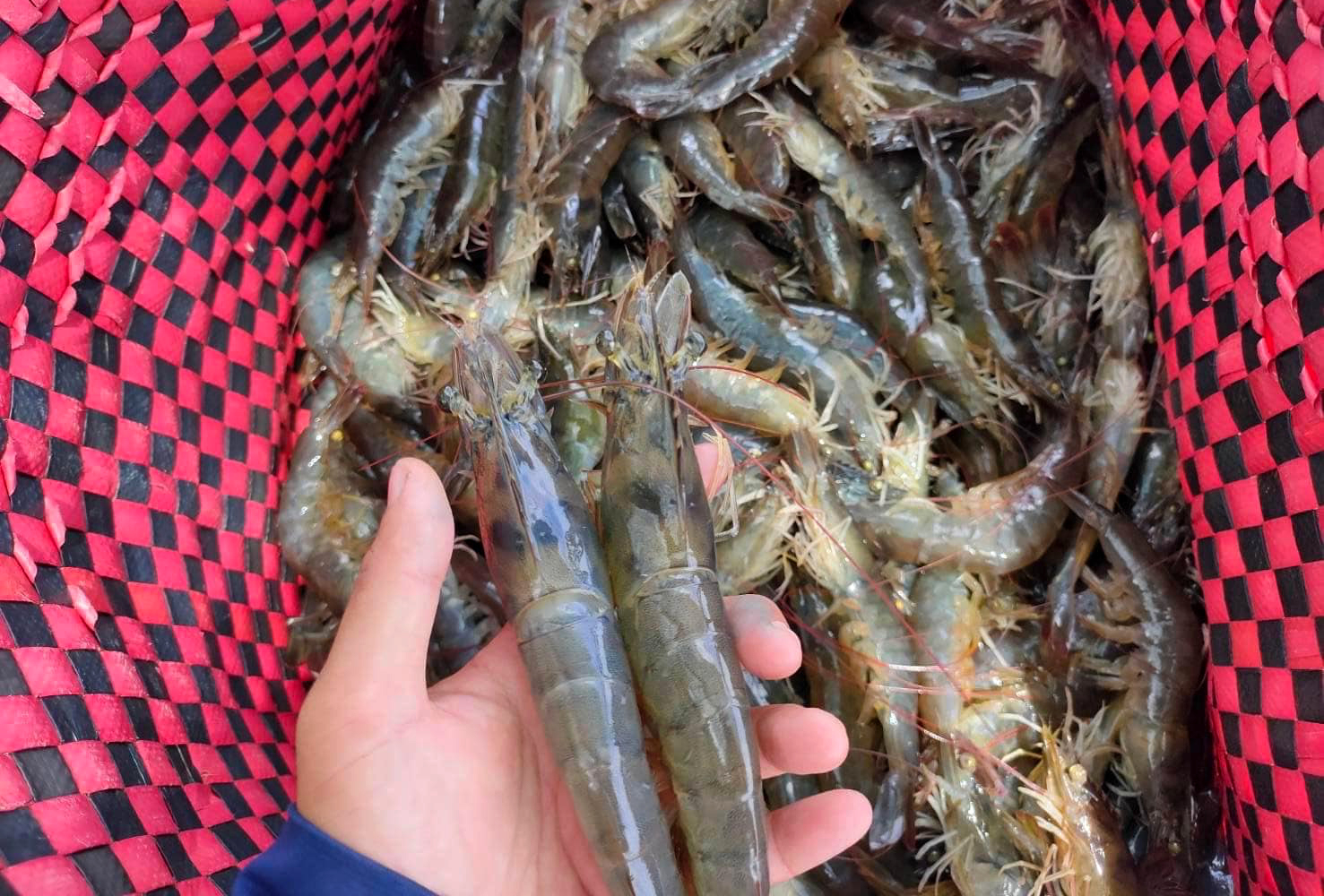May 22, 2025 | 08:33 GMT +7
May 22, 2025 | 08:33 GMT +7
Hotline: 0913.378.918
May 22, 2025 | 08:33 GMT +7
Hotline: 0913.378.918

A Vietnamese deep-processed shrimp product. Photo: Son Trang.
Due to their higher prices compared to shrimp from many other countries, including Ecuador and India, Vietnamese shrimp have long faced various disadvantages in the global shrimp market. According to the Foreign Agricultural Services Agency under the US Department of Agriculture, the price of Vietnamese shrimp imports into the US averaged at 10.7 USD per kilogram in the first quarter of 2023. On the other hand, the average price of imported Indian shrimp is 8.2 USD per kilogram; Ecuadorian shrimp 6.7 USD per kilogram.
In recent years Vietnam's shrimp industry has focused on strong key products such as large-sized shrimp and deep-processed shrimp within the last few years in order to compete in the global market.
According to Dr. Ho Quoc Luc, Chairman of the Board of Directors of Sao Ta Food Joint Stock Company, the price of large-sized shrimp exports from Vietnam decreased by 30% in 2023. The rapid growth of large-sized shrimp farming in countries around the world has led to this decline. This change has consequently increased the amount of large-sized shrimp produced.
Another strength in Vietnam's shrimp industry is its processing capacity. Vietnam and Thailand currently possess the highlest level of processing capacity in the shrimp processing industry, out of the six largest shrimp exporting countries around the world. As a result, despite the strong competitive pressure caused by affordable shrimp from India and Ecuador, Vietnamese shrimp has maintained its ground in the global market, even obtaining the largest market share in many fastidious markets.
Information from the Vietnam Association of Seafood Exporters and Producers (VASEP) shows that processed shrimp accounted for 40% of the total value of Vietnamese shrimp exports to Australia within the first eight months of 2022. With these figures, processed shrimp has made a substantial contribution to helping Vietnam's shrimp exports to Australia reach 272 million USD in 2022, which is an increase of 44% compared to that of 2021. Subsequently, Vietnam's shrimp exports continue to hold the largest market share in the Australian market.
Regarding the Japanese market, Vietnamese shrimp has maintained a largest market share, including a a significant contribution from deep-processed products. The Japanese market requires delicate and meticulous processing techniques which are met by the processing capacity of Vietnamese shrimp production businesses.

Freshly harvested shrimp in Can Gio district, Ho Chi Minh city. Photo: Son Trang.
VASEP reported that Vietnamese shrimp products processed for export to Japan retain an advantage over other markets. Vietnam's key exports to Japan consist of products such as frozen breaded shrimp, frozen steamed black tiger shrimp, breaded shrimp, frozen PDTO Nobashi vannamei, frozen steamed black tiger shrimp, frozen steamed white leg shrimp with tail, frozen steamed shrimp with head and tail removed, frozen steamed white shrimp among many others.
According to Dr. Ho Quoc Luc, although shrimp exports faced numerous challenges within the first half of 2023, Vietnamese shrimp still dominated with the largest market share of deep-processed products in major markets around the world.
However, other major shrimp exporting countries are also making great efforts to improve their shrimp processing capacities. As a result, Dr. Ho Quoc Luc suggested Vietnam's shrimp industry to continue enhancing its processing level, with a product strategy that focuses on higher development steps. For example, there are highly complex processed shrimp products that can potentially attract more customers compared to basic products. Regarding the strong and near-monopolistic areas in the Vietnam's shrimp industry, they must also be continually strengthened and improved to maintain their positions in the global market.
According to the Ministry of Agriculture and Rural Development, the shrimp industry faced countless difficulties in the year 2022. Most notably, the Covid-19 pandemic as well as the conflict between Russia and Ukraine has had a strong impact on the global value chain. Consequently, fuel prices are unstable, whereas prices of materials, petrol and aqua feeds rapidly rose.
Thanks to the drastic and effective direction from the Government, Prime Minister, local governments as well as the active participation of guilds and associations; the efforts of fishermen across Vietnam, the results of shrimp farming in 2022 were remarkable. Accordingly, the export turnover of Vietnamese shrimp reached approximately 4.3 billion USD in 2022, which is the highest figure ever recorded.
Translated by Nguyen Hai Long
![Reducing emissions from rice fields: [2] Farmers’ commitment to the soil](https://t.ex-cdn.com/nongnghiepmoitruong.vn/608w/files/news/2025/05/05/dsc08881jpg-nongnghiep-140632.jpg)
(VAN) Clean rice cultivation model in Thuong Tan commune, Bac Tan Uyen district, is assisting local residents in achieving sustainable agriculture by substantially reducing costs, increasing productivity, and protecting the environment.

(VAN) At the conference to disseminate Resolution No. 68, AgriS introduced its digital agricultural ecosystem and reaffirmed its commitment to accompanying the Government in promoting private sector development and sustainable agriculture.

(VAN) 'Blue Ocean - Blue Foods' initiative is designed to restore marine ecosystems and establish sustainable livelihoods for local communities by cultivating a minimum of 1,000 hectares of cottonii seaweed in the first three years.
/2025/05/21/4642-3-112707_603.jpg)
(VAN) The V-SCOPE project has made direct contributions to three out of six pillars of the Comprehensive Strategic Partnership between Vietnam and Australia.

(VAN) Facing the threat of rabies spreading to the community, Gia Lai province urgently carries out measures to vaccinate dogs and cats on a large scale.

(VAN) Disease-free livestock farming not only protects livestock herds but also stabilizes production and livelihoods for many farmers in Tuyen Quang.

(VAN) Japan's grant aid project contributes to capacity building, promoting organic agricultural production, and fostering sustainable community development in Dong Thap province.